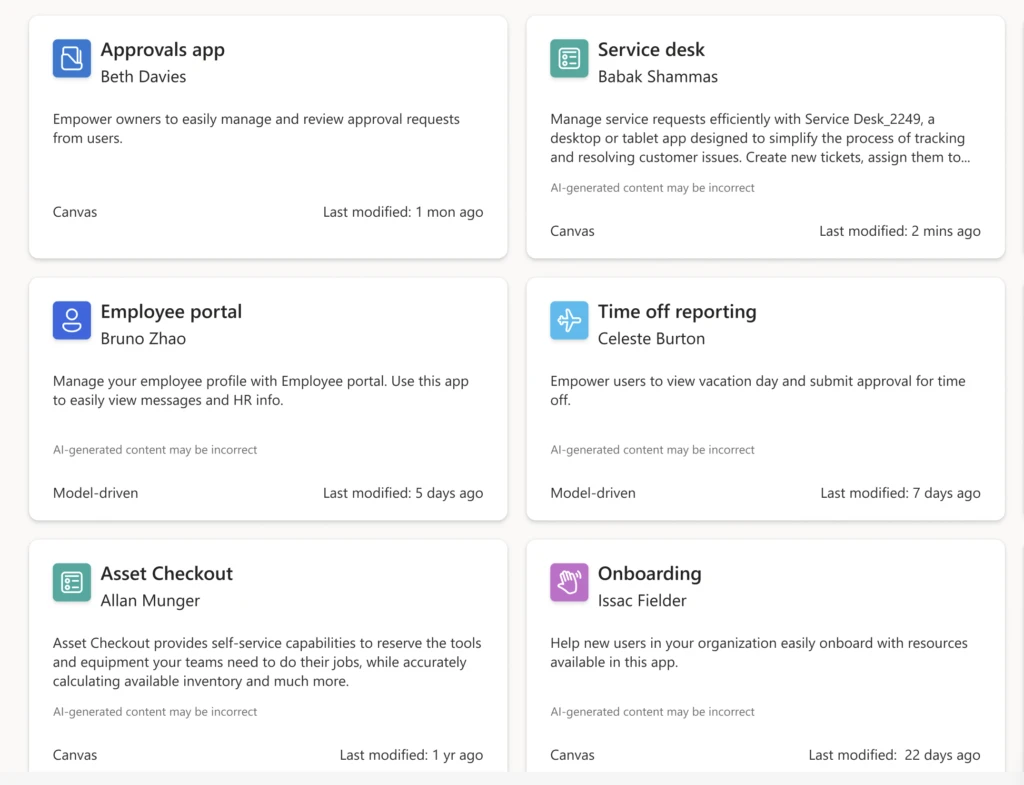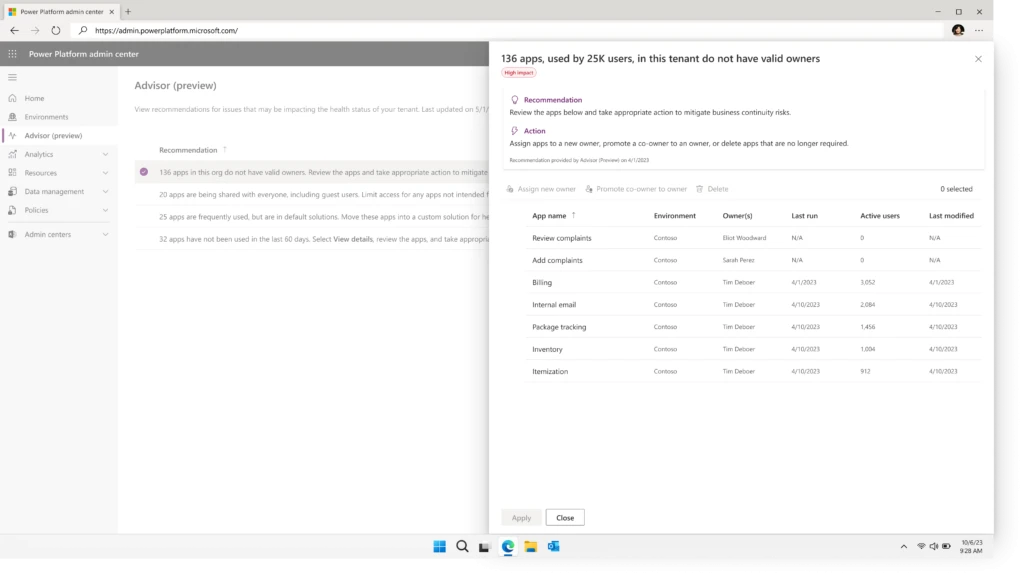
Power Apps announces new Copilot abilities, modern controls, and governance tools at the Power Platform Conference
As we kick off the second edition of the Microsoft Power Platform Conference (MPPC), we’re excited to share a raft of Microsoft Power Apps advancements across AI, governance, and modern UX. Here are the highlights we’ll focus on this week, with details and demos below:
- Copilot in Power Apps is revolutionizing the way we think about building and using apps, making developers faster and more agile than ever before. The list of what you can do with Copilot is growing, with more complex layout and data tasks coming to the Power Apps Studio. Now you can also add an even more powerful Copilot for your end users, which works over both the data in your app as well as websites or other content sources, all backed by Power Virtual Agents.
- Enterprise-grade governance is more important than ever in the age of AI. Managed Environments, generally available at MPPC one year ago, have given administrators more visibility and more control with less effort. Now we’re taking those capabilities to the next level with new tools for environment routing, delegated deployments, and AI-generated deployment notes and app descriptions.
- Modern user experiences will be shaped by Copilot, which in turn raises the bar for the rest of the UX platform. It’s now easier to deliver apps that are fast, delightful, collaborative, and available on every device. We’ve made advancements in modern controls, introduced a new theming engine, and continue to improve mobile Power Apps—including new support for offline data in canvas apps.
I invite you to build AI-powered applications with Power Apps.
Copilot drives maker productivity and user delight
More than 63,000 organizations have already used generative AI capabilities in Microsoft Power Platform.1 Copilot is making building and using apps easier and faster.
For makers, Copilot in Power Apps helps you build apps faster than ever before. Now you can add and edit multiple Microsoft Dataverse tables using Copilot directly within the Power Apps Studio, making it possible to work on more sophisticated apps with the power of natural language assistance. Copilot can also now answer app building questions that include terms, jargon, and formulas—in addition to helping you directly edit and update properties of your apps. Copilot is getting new skills every week; give it a try in Studio today and help shape the future of AI-powered app development.
And now, you can bring the power of Copilot to your end users with an expanded Copilot control that can answer questions over the data in your app and multiple external websites. In model-driven apps, the new Copilot-powered summarize action will automatically generate summaries of any record when users navigate to a form, saving valuable time when a new user is coming up to speed. Now built on Power Virtual Agents for powerful, multi-data-source generative answers and limitless extensibility, the Copilot control makes app experiences possible that were unimaginable just 12 months ago.
Managed Environment advancements empower low-code at high scale
Twelve months ago, we released Managed Environments to help administrators streamline governance. According to Gartner’s Kyle Davis, “Managed Environments offers unique features that allow organizations to better support self-service development and adaptable governance at scale.”
Today, we are excited to announce the next wave of Managed Environments capabilities to enable governable citizen development at scale. With the public preview of Default Environment Routing, admins can now automatically direct new makers into their own personal developer environment instead of the shared default environment. Makers automatically get a dedicated, safe, personal environment to innovate, and for admins, it’s much easier to manage app sprawl. Existing Managed Environment capabilities, including maker onboarding and sharing limits, help new makers begin their low-code journey quickly and safely.
We’ve also made it easier for makers to deploy their apps to production with easy on-ramps to pipelines—our in-product application lifecycle management (ALM) capabilities—when makers share or publish. Citizen developers can do so with approval and without elevated permissions with delegated deployments. Admins can secure production environments and data with a permissioned service principal. This follows the least privileged access policies of the organization.
With the help of Copilot, makers will create more applications, and more releases than ever. Admins need to keep up with this rapid development pace. Copilot’s AI-generated deployment notes give them more visibility into the assets that they approve and manage. All apps in managed environments will also include Copilot-generated app descriptions—that makers can edit—to help IT better understand the apps that they support and improve end user app discovery.

Finally, Power Platform advisor now provides admins with proactive recommendations and inline actions to govern and secure the platform more easily. This includes recommendations to clean up unused apps, lock down over-shared apps, and add owners to abandoned apps. Customers can join the private preview.

Modern experiences for everyone and everywhere
Apps built with Power Apps now all benefit from a modern user interface aligning to the latest Microsoft Fluent Design System. This provides makers with beautiful controls and experiences to delight their users.
We’re introducing three new composite controls—Header, Table, and Form for Canvas apps. These controls join (and build on) the 20 modern controls already available that are based on the Microsoft Fluent design system, but take things to the next level by providing more complex interactions out of the box. These new controls are responsive by design, making makers faster when building their apps.
We also released the new, refreshed look of model apps in August in the monthly channel, which will be available in the semi-annual channel for all customers in release wave 2 this month.
Customers worldwide in banking, IT, and manufacturing have adopted modern controls for their canvas apps.
We’re also introducing a brand new theming system which generates a color ramp to be used for app design and controls styling. This will help makers build beautiful, accessible, and performant apps quicker by simplifying styling and reducing the need to manage style at each control level. The theming system also works for classic and custom controls via Power Fx.
We also recently announced built-in offline for canvas apps. Now, makers can easily enable canvas apps to work performantly regardless of their user’s location or connectivity status. With the flip of a switch, makers can make Dataverse data in canvas apps available offline, and built-in offline will handle all the complexity of determining needed data, managing syncs, and sharing network state.
With Power Apps you can do it all
It’s our mission at Microsoft to enable every individual on the planet. Power Apps empowers new makers and enables professional developers to build the smart way for every need and for the benefit of the users.
Our Power Platform community groups have roughly doubled in the past year since the first Microsoft Power Platform Conference because the makers see that with Power Apps, they can build solutions that matter.
For those who wish to follow the Power Platform Conference remotely, look up #MPPC23 on X and LinkedIn or follow the conference on X at PowerPlatformConf.
And, lastly, for those interested, please join the Microsoft Power Platform community.
What’s next
We’re marching on towards our vision to enable every developer to build every solution on one comprehensive platform. Register for Microsoft Ignite, November 14–17, 2023, where you can learn more about Microsoft Power Platform and also about even more great new capabilities coming to the platform.
Sources
1 Satya Nadella, FY23Q4 Earnings Call TranscriptFY23Q4.docx (live.com)
